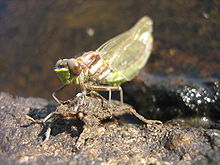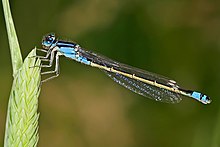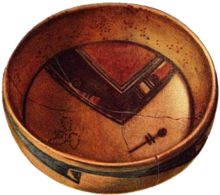Dragonfly: Difference between revisions
ClueBot NG (talk | contribs) m Reverting possible vandalism by 68.96.135.134 to version by 72.130.178.144. False positive? Report it. Thanks, ClueBot NG. (1701076) (Bot) |
No edit summary |
||
| Line 142: | Line 142: | ||
==External links== |
==External links== |
||
{{wiktionary|dragonfly}} |
|||
{{commons category|Anisoptera}} |
{{commons category|Anisoptera}} |
||
{{wikispecies|Anisoptera}} |
{{wikispecies|Anisoptera}} |
||
Revision as of 21:33, 3 September 2013
| Dragonfly | |
|---|---|

| |
| Yellow-winged Darter | |
| Scientific classification | |
| Domain: | Eukaryota |
| Kingdom: | Animalia |
| Phylum: | Arthropoda |
| Class: | Insecta |
| Order: | Odonata |
| Suborder: | Epiprocta |
| Infraorder: | Anisoptera Selys, 1854 |
| Families | |
A dragonfly is an insect belonging to the order Odonata, the suborder Epiprocta or, in the strict sense, the infraorder Anisoptera (from Greek ανισος anisos, "uneven" + πτερος pteros, "wings", because the hindwing is broader than the forewing).[1] It is characterized by large multifaceted eyes, two pairs of strong transparent wings, and an elongated body. Dragonflies can sometimes be mistaken for damselflies, which are morphologically similar; however, adults can be differentiated by the fact that the wings of most dragonflies are held away from, and perpendicular to, the body when at rest. Dragonflies possess six legs (like any other insect), but most of them cannot walk well. Dragonflies are among the fastest flying insects in the world.
Dragonflies are important predators that eat mosquitoes, and other small insects like flies, bees, ants, wasps, and very rarely butterflies. They are usually found around marshes, lakes, ponds, streams, and wetlands because their larvae, known as "nymphs", are aquatic. Some 5680 different species of dragonflies (Odonata) are known in the world today.[2]
Though dragonflies are predators, they themselves are subject to predation by birds, lizards, frogs, spiders, fish, water bugs, and even other large dragonflies.
Classification
Formerly, the Anisoptera were given suborder rank beside the "ancient dragonflies" (Anisozygoptera), which were believed to contain the two living species of the genus Epiophlebia and numerous fossil ones. More recently it turned out that the "Anisozygopterans" form a paraphyletic assemblage of morphologically primitive relatives of the Anisoptera. Thus, the Anisoptera (true dragonflies) are reduced to an infraorder in the new suborder Epiprocta (dragonflies in general). The artificial grouping Anisozygoptera is disbanded, its members recognized as extinct offshoots at various stages of dragonfly evolution. The two living species formerly placed there—the Asian relict dragonflies—form the infraorder Epiophlebioptera alongside Anisoptera.
Life cycle


Female dragonflies lay eggs in or near water, often on floating or emergent plants. When laying eggs, some species will submerge themselves completely in order to lay their eggs on a good surface. The eggs then hatch into naiads. Most of a dragonfly's life is spent in the naiad form, beneath the water's surface, using extendable jaws to catch other invertebrates (often mosquito larvae) or even vertebrates such as tadpoles and fish.[3] They breathe through gills in their rectum, and can rapidly propel themselves by suddenly expelling water through the anus.[4] Some naiads even hunt on land,[5] an aptitude that could easily have been more common in ancient times when terrestrial predators were clumsier.
The larval stage of large dragonflies may last as long as five years. In smaller species, this stage may last between two months and three years. When the naiad is ready to metamorphose into an adult, it climbs up a reed or other emergent plant. Exposure to air causes the naiad to begin breathing. The skin splits at a weak spot behind the head and the adult dragonfly crawls out of its larval skin, pumps up its wings, and flies off to feed on midges and flies. In flight the adult dragonfly can propel itself in six directions; upward, downward, forward, back, and side to side.[6] The adult stage of larger species of dragonfly can last as long as five or six months.
Flight speed
Tillyard claimed to have recorded the Southern Giant Darner flying at nearly 60 miles per hour (97 km/h) in a rough field measurement.[7] However, the greatest reliable flight speed records are for other types of insects.[8] In general, large dragonflies like the hawkers have a maximum speed of 10–15 metres per second (22–34 mph) with average cruising speed of about 4.5 metres per second (10 mph).[9]
Dragonflies and damselflies

Damselflies (suborder Zygoptera), typically smaller than dragonflies, are sometimes confused with newly moulted dragonflies. However, once a dragonfly moults, it is already fully grown. There are other distinctions that set them apart: most damselflies hold their wings at rest together above the torso or held slightly open above (such as in the family Lestidae), whereas most dragonflies at rest hold their wings perpendicular to their body, horizontally or occasionally slightly down and forward. Also, the back wing of the dragonfly broadens near the base, caudal to the connecting point at the body, while the back wing of the damselfly is similar to the front wing. The eyes on a damselfly are apart; in most dragonflies the eyes touch. Notable exceptions are the Petaluridae (Petaltails) and the Gomphidae (Clubtails).
The largest living odonate by wingspan is a damselfly from South America, Megaloprepus caerulatus (Drury, 1782) while the second largest are females of the dragonfly Tetracanthagyna plagiata (Wilson, 2009). The female T. plagiata is probably the heaviest living odonate.[10]
Common species
Northern hemisphere
|
|
Southern hemisphere
Gallery
-
Broad-bodied Chaser (Libellula depressa)
-
Tau Emerald (Hemicordulia tau)
-
Australian Emperor (Hemianax papuensis)
-
Pacific Spiketail (Cordulegaster dorsalis), Salmon Arm, BC, Canada
Dragonflies in culture
In Europe, dragonflies have often been seen as sinister. Some English vernacular names, such as "devil's darning needle" and "ear cutter", link them with evil or injury.[11] A Romanian folk tale says that the dragonfly was once a horse possessed by the devil.[citation needed] Swedish folklore holds that the devil uses dragonflies to weigh people's souls.[12]: 25–27 The Norwegian name for dragonflies is Øyenstikker ("eye-poker"), and in Portugal they are sometimes called tira-olhos ("eye-snatcher"). They are often associated with snakes, as in the Welsh name gwas-y-neidr, "adder's servant".[11] The Southern United States term "snake doctor" refers to a folk belief that dragonflies follow snakes around and stitch them back together if they are injured.[13]

For some Native American tribes they represent swiftness and activity, and for the Navajo they symbolize pure water. Dragonflies are a common motif in Zuni pottery; stylized as a double-barred cross, they appear in Hopi rock art and on Pueblo necklaces.[12]: 20–26
They have also been used in traditional medicine in Japan and China. In some parts of the world they are a food source, eaten either as adults or larvae; in Indonesia, for example, they are caught on poles made sticky with birdlime, then fried in oil as a delicacy.[11]
In the United States dragonflies and damselflies are sought out as a hobby similar to birding and butterflying, known as oding, from the Latin name of the dragonfly order, Odonata. Oding is especially popular in Texas, where 225 different species of odonates have been observed. With care, and with dry fingers, dragonflies can be handled and released by oders, as can be done with butterflies, though it is not encouraged.[14]
Images of dragonflies are common in Art Nouveau, especially in jewelry designs.[15] They also appear in posters by modern artists such as Maeve Harris.[16] They have also been used as a decorative motif on fabrics and home furnishings.[17] Douglas, a British motorcycle manufacturer based in Bristol, named its innovatively designed postwar 350cc flat twin model the Dragonfly.
Japan
As a seasonal symbol in Japan, the dragonfly is associated with summer and early autumn.[18] More generally, dragonflies are symbols of courage, strength, and happiness, and they often appear in art and literature, especially haiku. The love for dragonflies is reflected by traditional (layman's) names for almost all of the 200 species of dragonflies found in and around Japan.[19] Japanese children catch large dragonflies as a game, using a hair with a small pebble tied to each end, which they throw into the air. The dragonfly mistakes the pebbles for prey, gets tangled in the hair, and is dragged to the ground by the weight.[12]: 38
Beyond this, one of Japan's historical names – Akitsushima (Kanji: 秋津島 Hiragana: あきつしま) – is an archaic form meaning "Dragonfly Islands".[20] This is attributed to a legend in which Japan's mythical founder, Emperor Jinmu, was bitten by a mosquito, which was then promptly eaten by a dragonfly.[21][22]
See also
- Aeshnoidea
- Cordulegastroidea
- Elliot Pinhey
- Libelluloidea
- List of British dragonflies
- Obelisk posture
References
- ^ Odonata at Tree of Life web project. Retrieved 2011-09-18.
- ^ V.J. Kalkman, V. Clausnitzer, K.B. Dijkstra, A.G. Orr, D.R. Paulson, J. van Tol (2008). E. V. Balian, C. Lévêque, H. Segers & K. Martens (ed.). "Freshwater Animal Diversity Assessment". Hydrobiologia. 595 (1): 351–363. doi:10.1007/s10750-007-9029-x.
{{cite journal}}:|chapter=ignored (help)CS1 maint: multiple names: authors list (link) - ^ Dragon fly naiad labium extended to capture prey
- ^ P. J. Mill & R. S. Pickard (1975). "Jet-propulsion in anisopteran dragonfly larvae". Journal of Comparative Physiology A: Neuroethology, Sensory, Neural, and Behavioral Physiology. 97 (4): 329–338. doi:10.1007/BF00631969.
- ^ Grzimeck, HC (1975). Grzimek's Animal Life Encyclopedia Vol 22. Detroit: Visible Ink Press. p. 348.
{{cite book}}: Unknown parameter|coauthors=ignored (|author=suggested) (help) - ^ Waldbauer, Gilbert (2006). A Walk Around the Pond: Insects in and Over the Water. Harvard University Press. p. 105. ISBN 9780674022119.
- ^ Tillyard, Robert John (1917). The Biology of Dragonflies (PDF). pp. 322–323. Retrieved 15 December 2010.
I doubt if any greater speed than this occurs amongst Odonata
- ^ T. J. Dean (2003-05-01). "Chapter 1 — Fastest Flyer". Book of Insect Records. University of Florida.
- ^ "Frequently Asked Questions about Dragonflies". British Dragonfly Society. Retrieved 5 July 2011.
- ^ T. M. Leong, S. L. Tay (2009). "Encounters with Tetracanthagyna plagiata (Waterhouse) in Singapore, with an Observation of Oviposition" (PDF). Nature In Singapore. 2. National University of Singapore: 115–119. Retrieved 14 December 2010.
- ^ a b c Corbet, Phillip S. (1999). Dragonflies: Behavior and Ecology of Odonata. Ithaca, NY: Cornell University Press. pp. 559–561. ISBN 0-8014-2592-1.
- ^ a b c Mitchell, Forrest L. (2005). A Dazzle of Dragonflies. College Station, TX: Texas A&M University Press. ISBN 1-58544-459-6.
{{cite book}}: Unknown parameter|coauthors=ignored (|author=suggested) (help) - ^ Hand, Wayland D. (1973). "From Idea to Word: Folk Beliefs and Customs Underlying Folk Speech". American Speech. 48 (1/2): 67–76. doi:10.2307/3087894. JSTOR 3087894.
- ^ Tracy Hobson Lehmann (June 19, 2008). "Dragonflying: the new birding". San Antonio Express-News.
- ^ Moonan, Wendy (August 13, 1999). "Dragonflies Shimmering as Jewelry". New York Times. pp. E2:38. ProQuest document ID 43893085.
- ^ "The Maeve Harris category contains 37 items". AllPosters.com. 2009-09-18. Retrieved 2009-09-18.
- ^ Large, Elizabeth (June 27, 1999). "The latest buzz; In the world of design, dragonflies are flying high". The Sun (Baltimore, MD). pp. 6N. ProQuest document ID 42880564.
- ^ Baird, Merrily (2001). Symbols of Japan: Thematic Motifs in Art and Design. New York: Rizzoli. pp. 108–9. ISBN 0-8478-2361-X.
- ^ Waldbauer, Gilbert (1998). The Handy Bug Answer Book. Detroit: Visible Ink Press. p. 91. ISBN 1-57859-049-3.
- ^ Nussbaum, Louis Frédéric et al. (2005). "Akitsushima" in Japan encyclopedia, p. 20., p. 20, at Google Books
- ^ Nihonto
- ^ 杉浦 (Sugiura), 洋一 (Youichi) (1999). 日本文化を英語で紹介する事典: A Bilingual Handbook on Japanese Culture (in Japanese & English). 日本国東京都千代田区 (Chiyoda, JP-13): 株式会社ナツメ社 (Kabushiki gaisha Natsume Group). p. 305. ISBN 4-8163-2646-4. Retrieved 2010-04-26.
{{cite book}}: Unknown parameter|coauthors=ignored (|author=suggested) (help)CS1 maint: location (link) CS1 maint: unrecognized language (link)
External links
- Tree of Life Odonata
- Template:Dmoz
- Identification key to dragonflies found in Ireland
- British Dragonfly Society
- Dragonflies and Damselflies (Odonata) of the United States
- Phaon (Pinhey's Heritage African Odonata Network)
- Dragonflies and damselflies on the UF / IFAS Featured Creatures Web site
- Photos of dragonflies from Asia-dragonfly.net, Africa-dragonfly.net, America-Dragonfly.net, Libellulasman.com and Odonata.su
- list of field guides to dragonflies, from the International Field Guides Database





